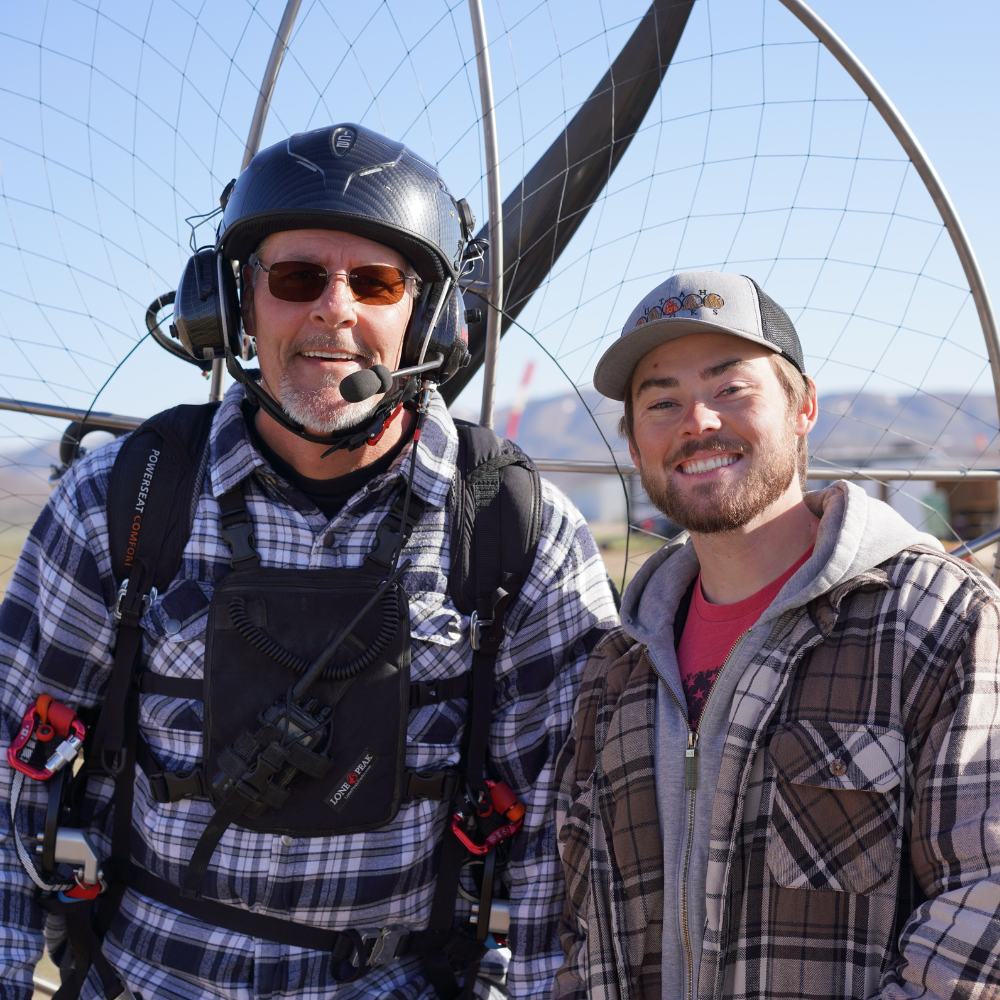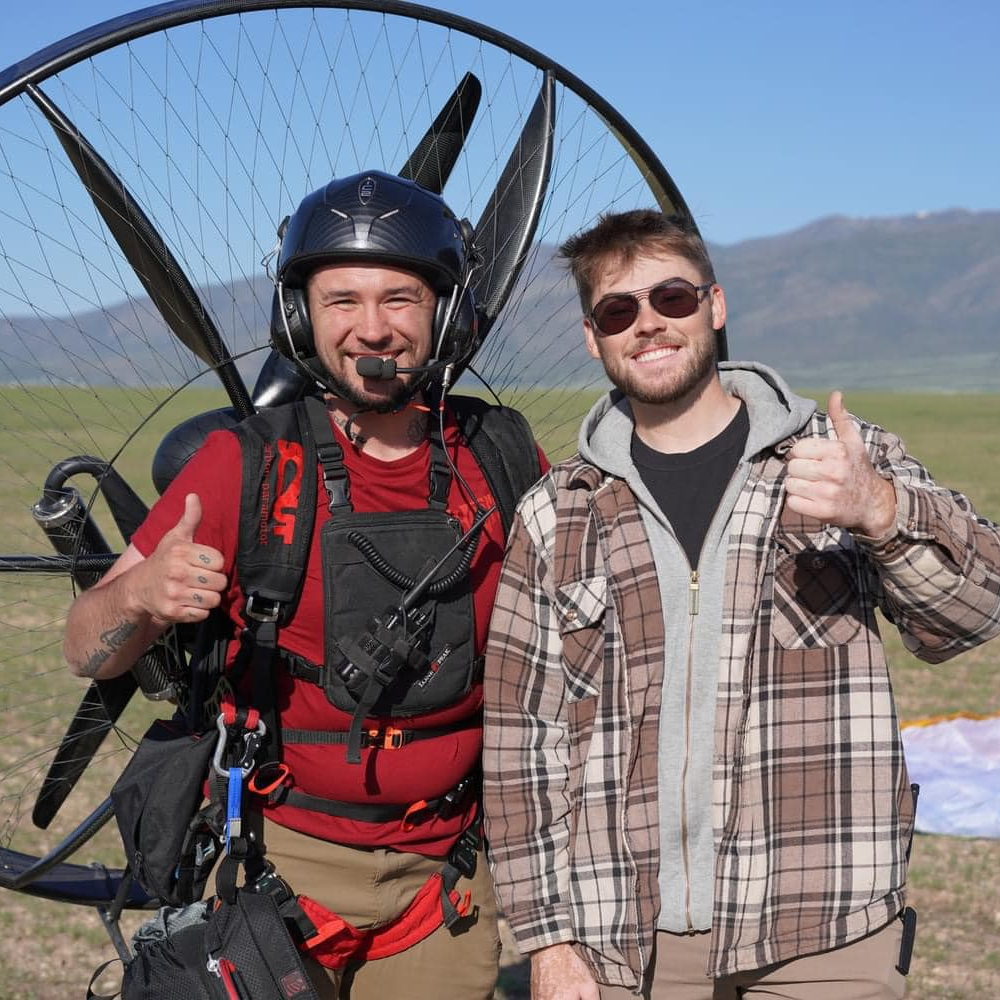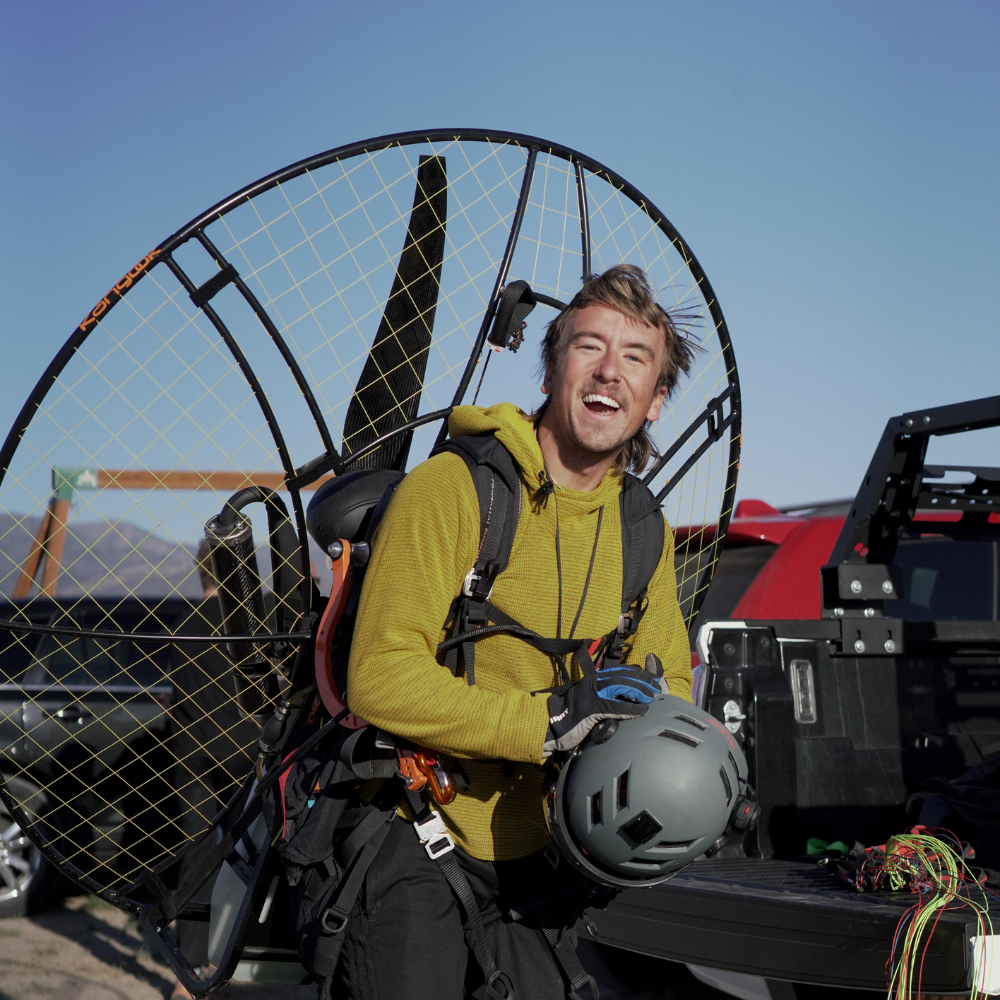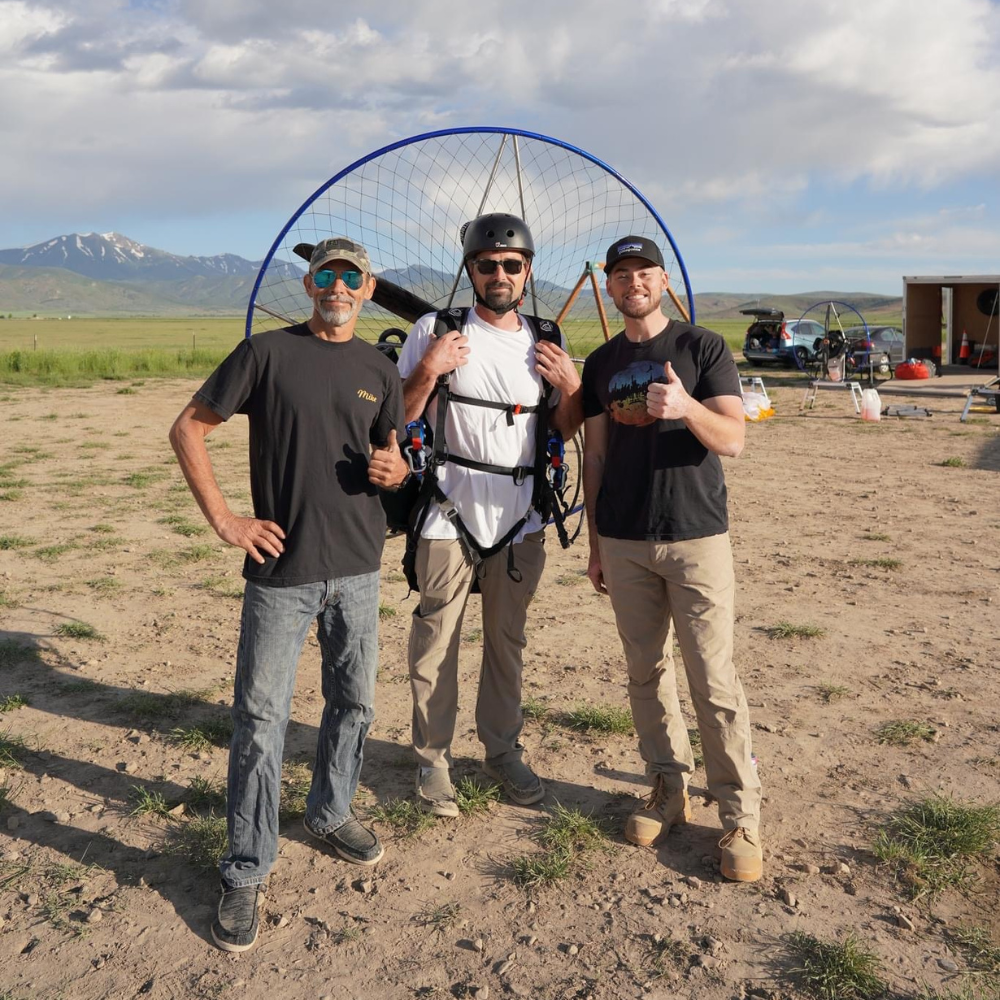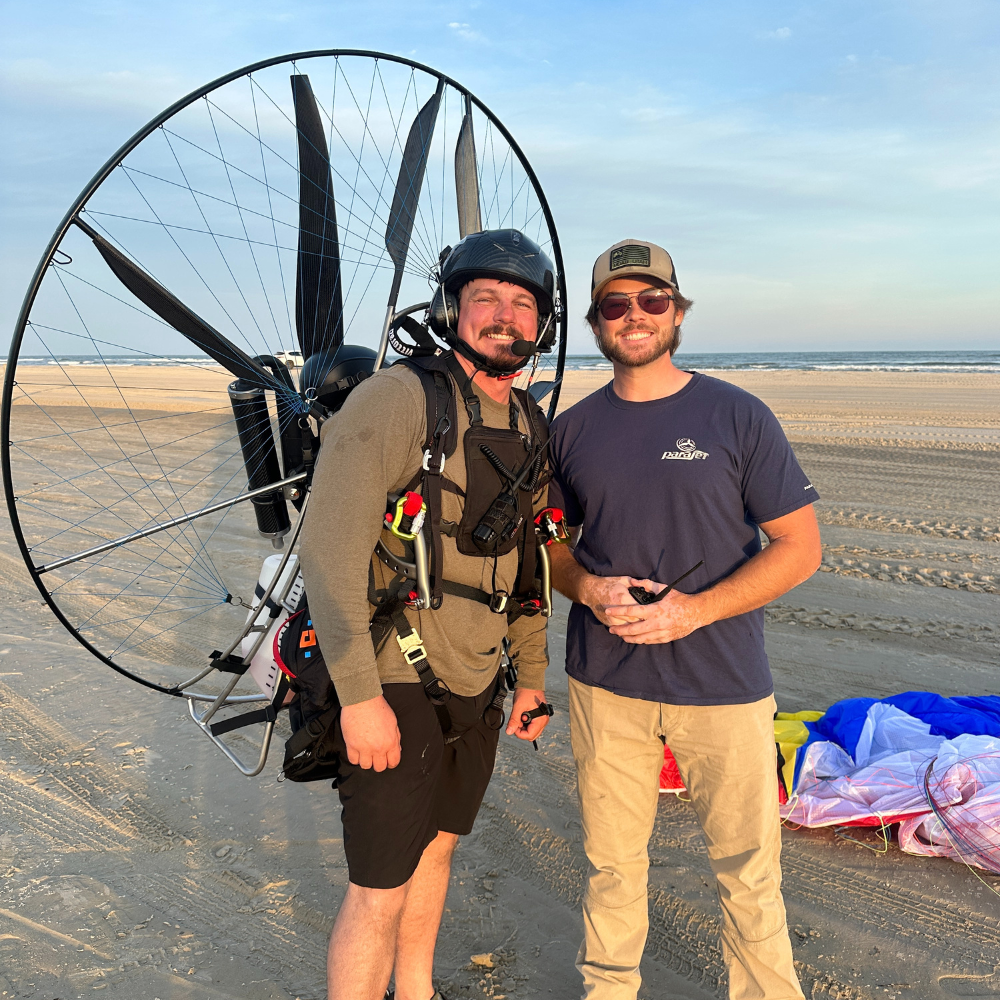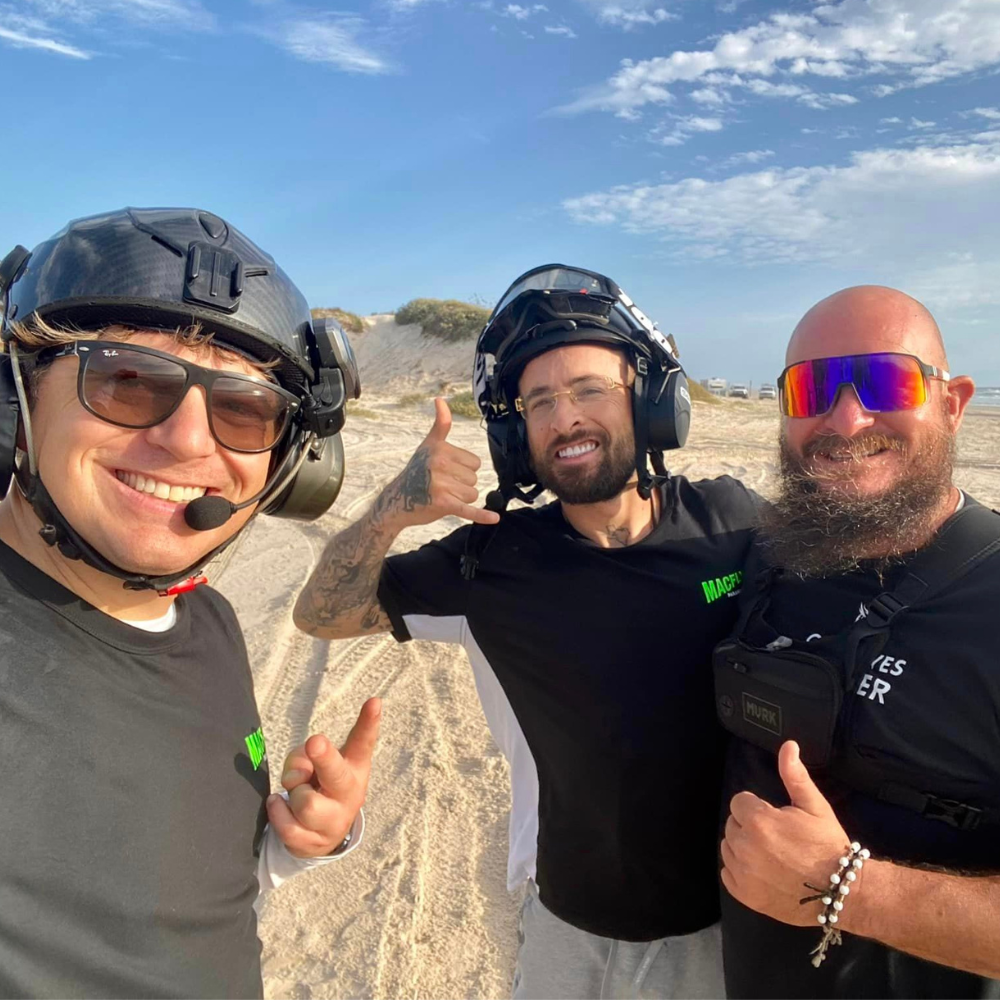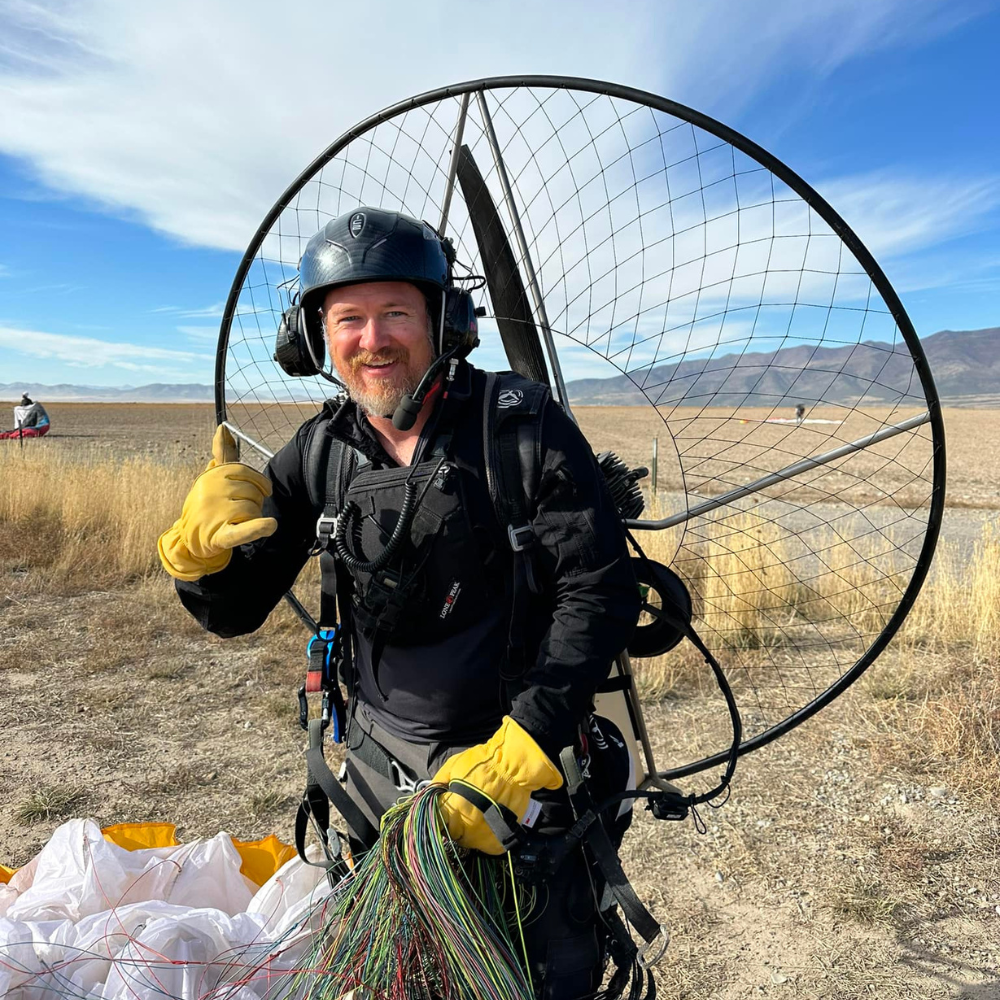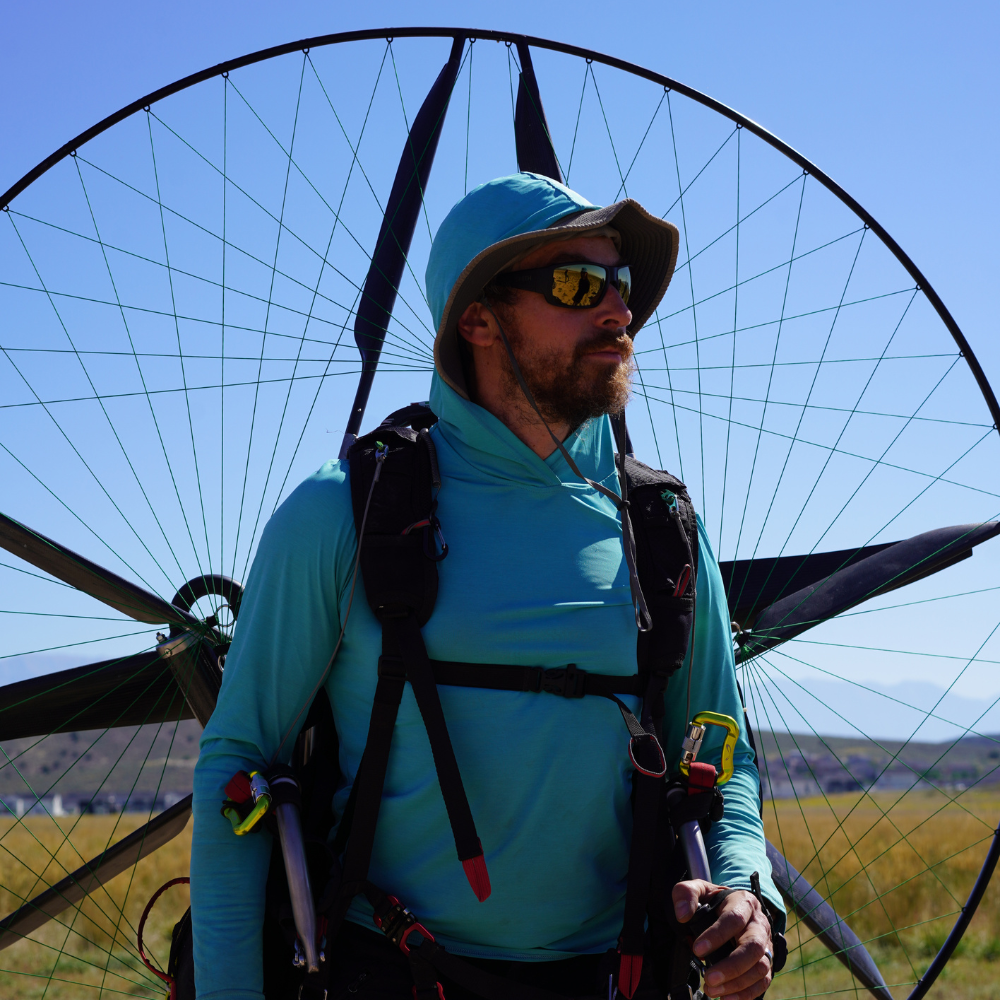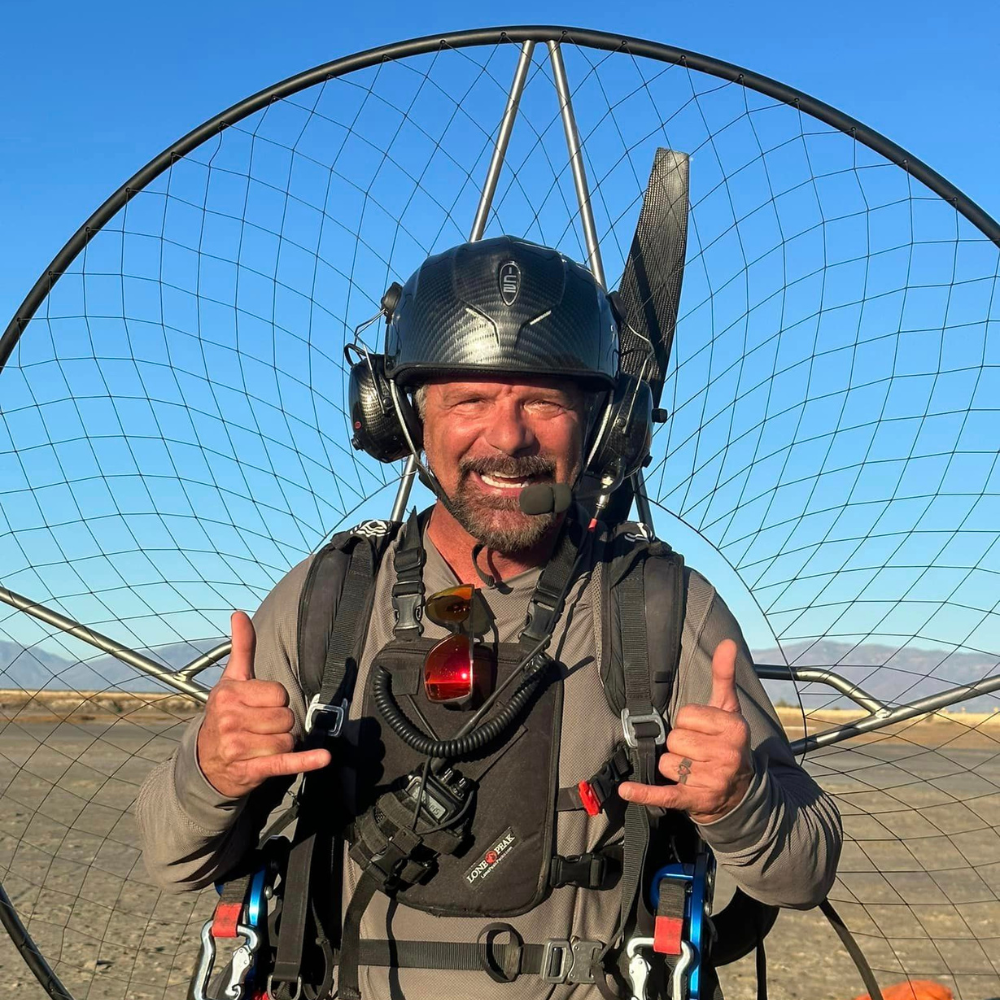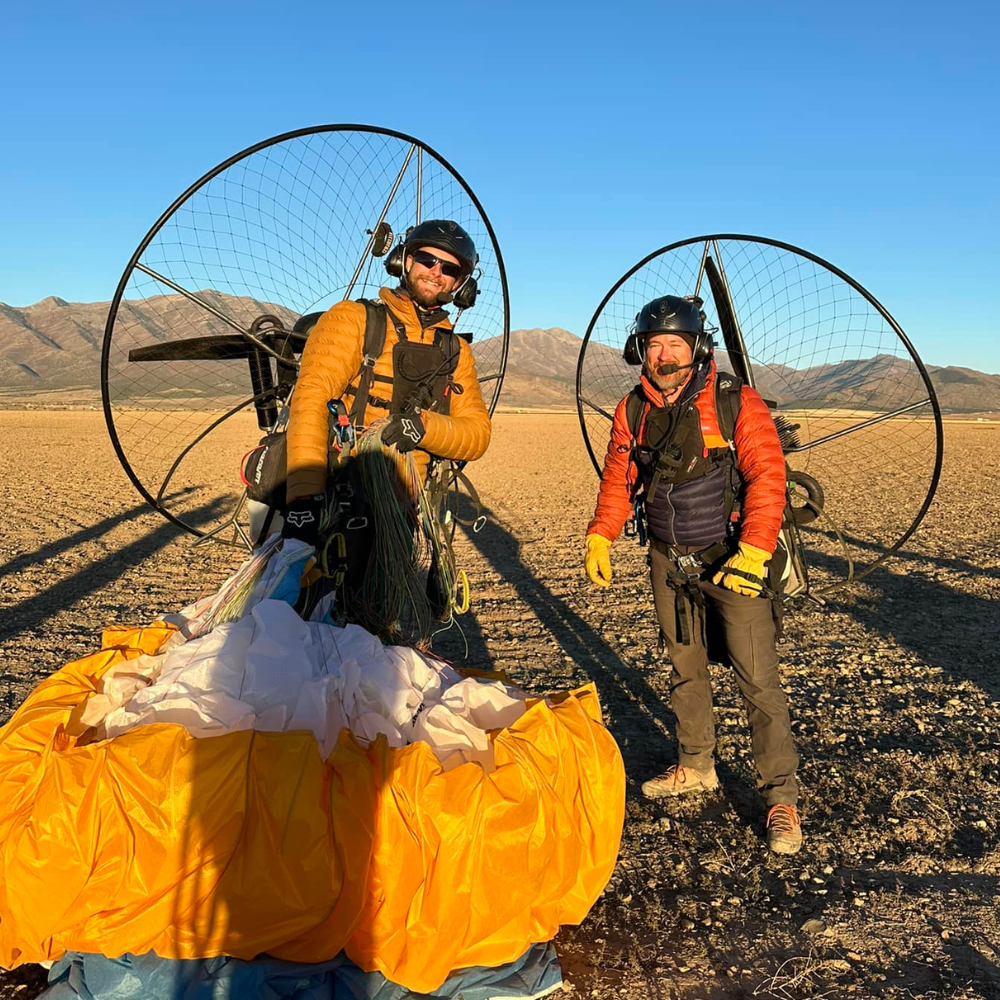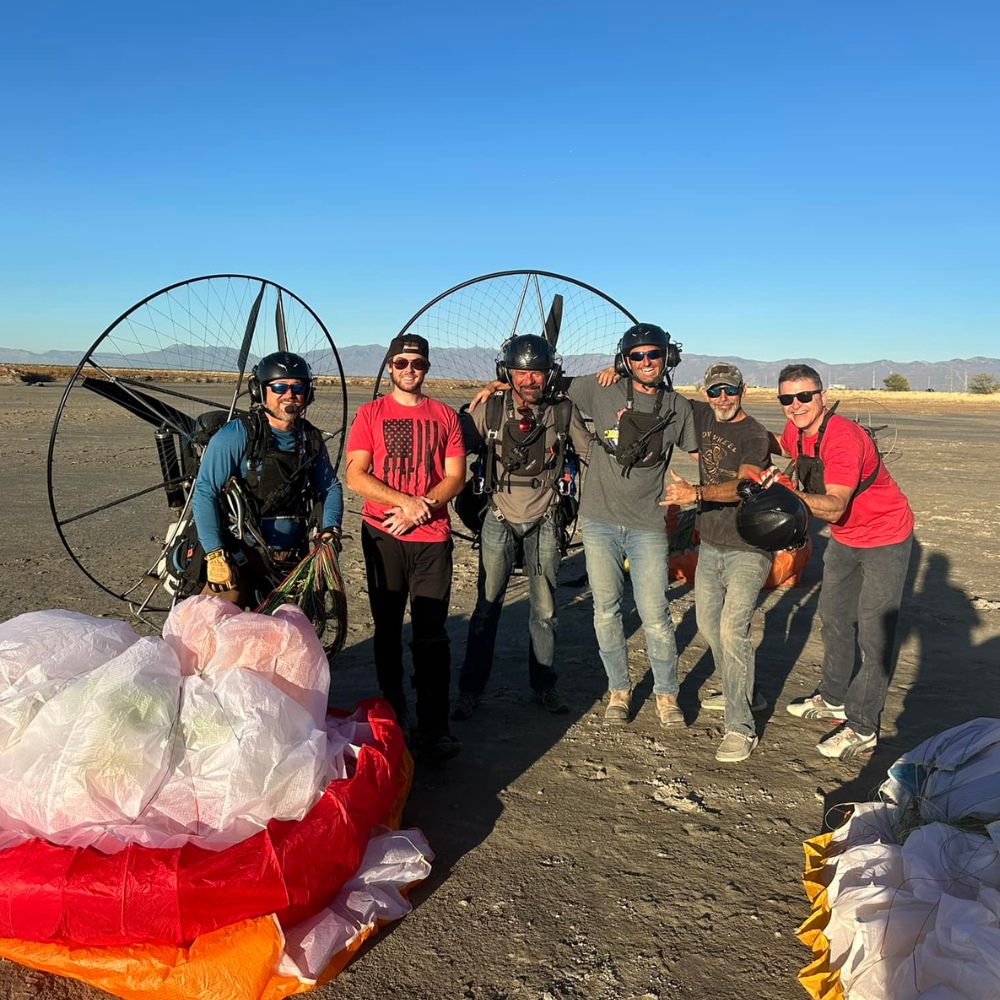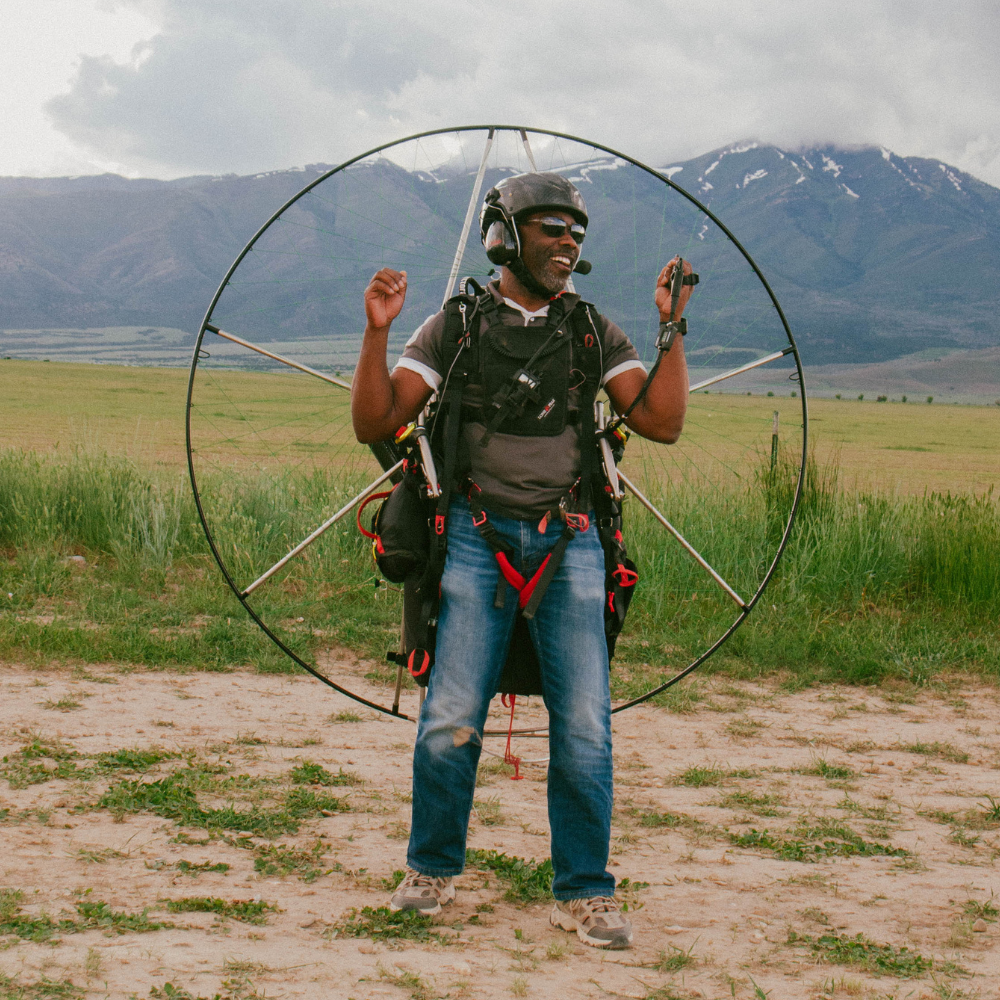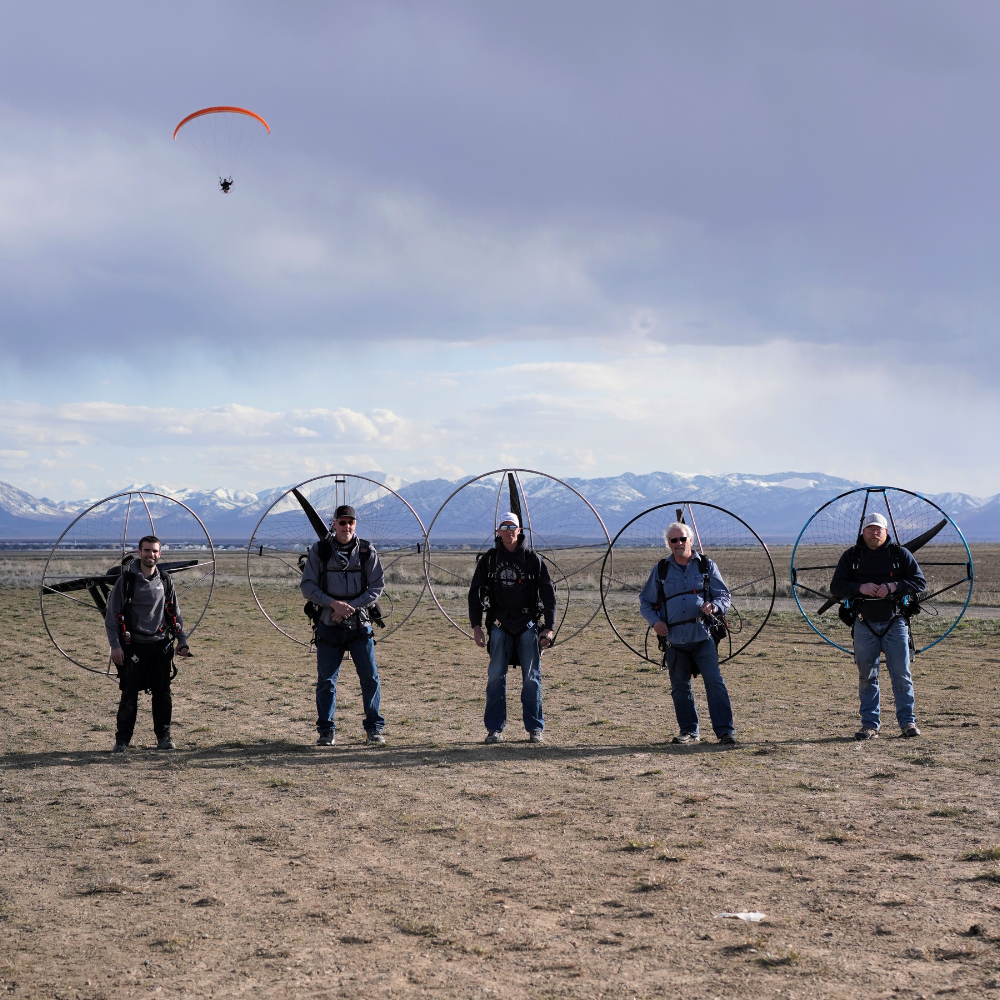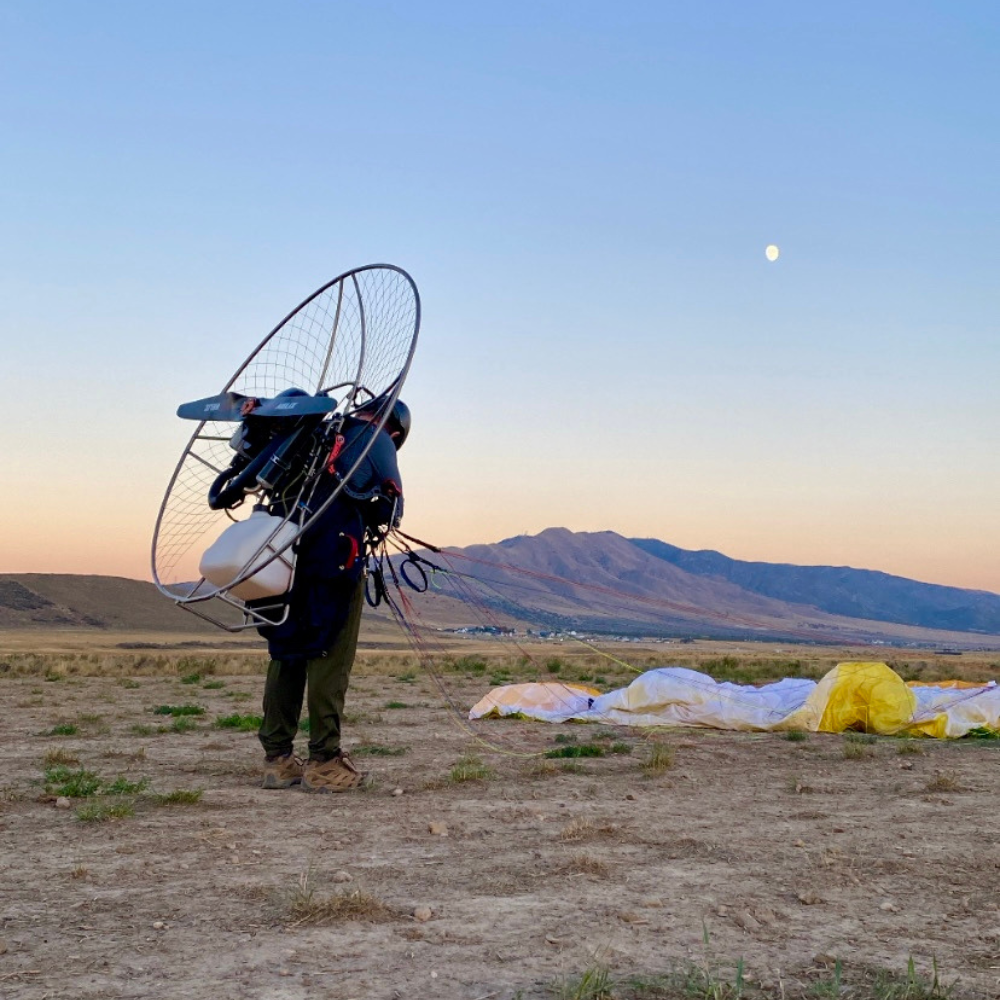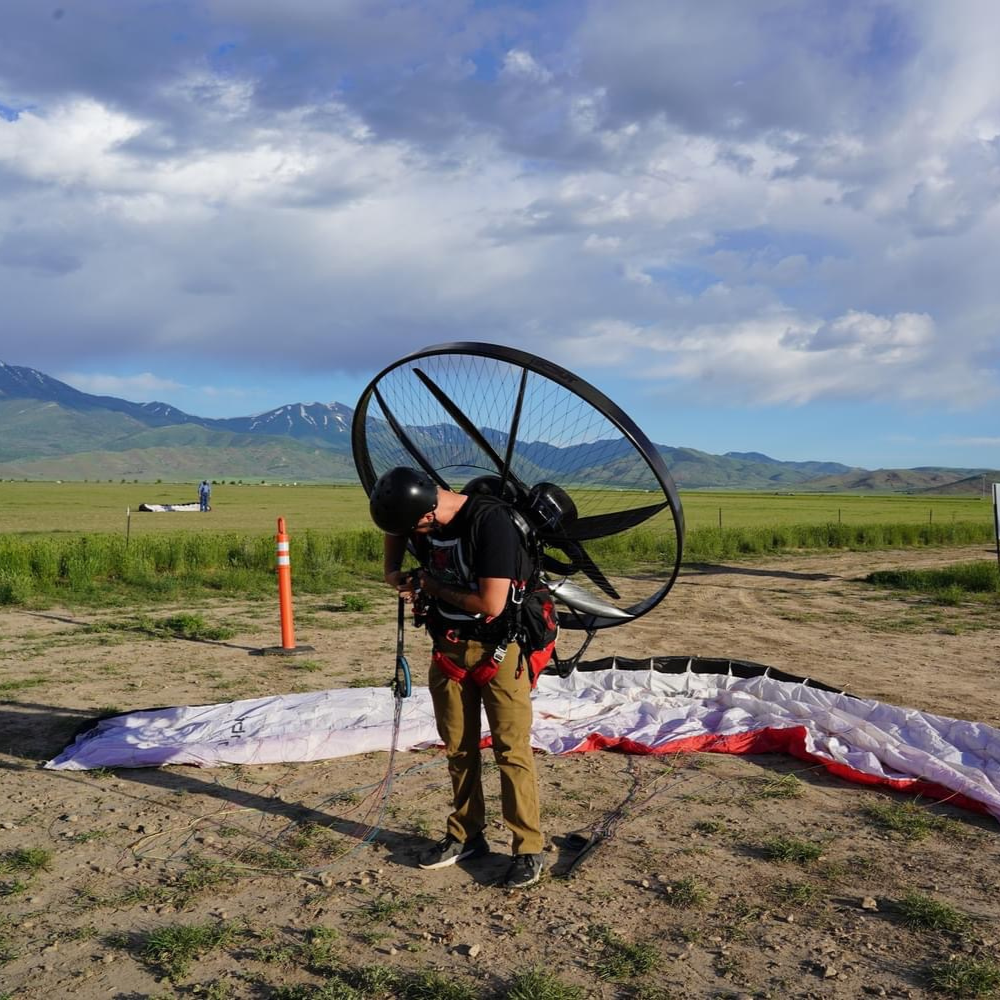Backcountry PPG
10-Day Beginner Paramotor Training
10-Day Beginner Paramotor Training
Couldn't load pickup availability
New To Paramotoring?
We Can Help!
This Video Outline's Everything You Need To Know:
Are you Prepared For The Most Fun 10-Days Of Your Entire Life?
Learning to fly a paramotor will be one of the most exciting and life changing experiences you will ever have. Be prepared to escape the craziness of daily life while fully emmersing yourself into the beautiful world of flying paramotors. You'll smile, laugh, and experience some of the most fun times of your entire life!
What Is PPG (Powered Paragliding)?
PPG, also known as paramotoring, is a form of ultralight aviation that doesn't require a license, annuals, medicals, or a hanger. A paramotor is a lightweight aircraft that you strap onto your back that can be launched in areas as small as a football field. They are a very affordable aircraft to maintain, and cost around $10 per hour to fly. Parmaotors are also small enough to be packed into the trunk of your vehicle, so you don't need a truck, trailer, or hanger to own one. They weigh around 55-60 pounds before fuel and can fly for up to 4 hours on a full tank. They're capable of flying at speeds up to 50 mph and can climb to 18,000 feet. They're a small but capable aircraft and can provide some of the most fun adventures you'll ever have.
- 3-4 hours of flight time
- 25-35 mph cruising speed
- 40-50 mph max speed
- 55-60 pound aircraft
- 300-pound pilots can easily fly them
- 18,000 feet max altitude
- No truck or trailer is needed for transport
- Tandem capable
Paramotors are the most simple & affordable aircraft there is

How Training At Backcountry PPG Works:
We've spent over a decade (2012-2025) developing a step by step "building block" approach that takes you from zero to hero in the smoothest and safest way possible. We've spent years refining our syllabus and in that process we've learned what really makes a difference in creating safe & successful pilots. Our structure is polished, refined, and designed to glide students through our curriculum smoothly.
Our training program is well strucutred to ensure no steps are skipped and information is missed. We're long past "winging it" and have hand crafted a step by step apporoach that leans into students natural learning style, regardless of what that is. The entire training is one on one despite being in a group enviroment. Meaning, each student will progresses at their own rate, and we cater every lesson toward what the student needs, in the style the student needs/wants it.
We start slow, only add one step at a time to not overwhelm you with information. Every step is clearly laid out so you never wonder what's next. As we build your skills and improve your technique, we continue adding more information and before long, you're ready to take your first flight.
We take safety very serious and understand the importance of outlining what makes a safe pilot and an unsafe pilot. We work very hard to ensure students not only have the physical skills to keep themselves safe, but the correct mindset to approach situations with safety in mind. We help outline where the edges are, what get's pilots in trouble, and how you can avoid those same situations. Our goal is that our students know how to safely navigate flying paramotors in a variaty of environments and conditions safely. Our students are held to a high standard, and we never let a student slip up on our safety cutoffs. We as instructors take our role very serious as we know that our students are trusting us with their lives.
- A clearly laid out step-by-step process from A-Z
- Building block approach
- Videos and visuals to help solidify what you're learning
- Visually focused ground school that's detailed and easy to remember
- Individual instruction that is at your own pace
- A variety of instructors are there to help the entire time
- Year round training with full time instructors
- 60+ hours of personal hands on in the field instruction
- 20+ hours of in person ground school instruction
- And more
We currently train over 100 students every year

Training Details:
- 10 days
- 6 students (strict)
- Up to 3 instructors
- Year round training
- Full time instructors
- $500 Upfront discount towards equipment
- 87% of our students are out of state
- No equipment purchase is required
- Equipment use is provided in the training
- Our instructors are certified USPPA instructors
- Receive official USPPA PPG ratings (if requested)
- Located in Salt Lake City, Utah (April-October)
- Located in southern California (November-March)
700+ happy students trained since 2012
Training Dates:
2025 Salt Lake City, Utah
Sept 20-29 (FULL)
Oct 18-27 (2 spots left)
Salton Sea, California
November 1-10 (1 spot left)
March 7-16 (2026) (1 spot left)
2026 Salt Lake City, Utah
April 25-4
May 16-25
June 6-15
August 29-7
September 19-28
October 10-19
Space is limited and fills up fast!
Training Logistics:
The training will run for about 4 hours in the morning and 4 hours in the evening with a break in the middle of the day. Usually, the morning training starts around 7:00 am and ends around 11:00 am. The evening session starts around 4:00 pm and ends around 8:00 pm.
Over the years of teaching paramotoring, 87% of our students come in from out of state. This includes a bunch of students who travel from out of country to visit our trianing with the furthest being Iceland, Switzerland, UK, Australia, and more! We are grateful to host and teach incredible students from around the world! For those who are traveling from further away, there are lots of local lodging options from Airbnb's to Hotel's to camping on site. Please feel free to reach out if you've got any additional questions.
Struggling with the 10-days commitment? We totally understand how hard it can be to free up your work schedule, personal schedule, and just life in general for 10 straight days. If you are unable to join us for all 10-days, we are OK with you breaking that up into multiple classes. Meaning, if you can only make 5 days of one class and 5 days of another class - that is OK and we will work with you to make that happen! Maybe you need to break it up into weekends - that is also OK! Again, we understand how hard getting that much time free in a row can be. Please reach out and we would be happy to help work something out that will it possible for you to join us!
If you are someone who needs to do some work during the training day, we also understand and there is time built into the day for that. We will realistically only be training for about 4 hours in the morning and 4 hours in the evening. The middle of the day is open for you to take care of anything that you need to take care of. And if you're someone who has a meeting here and there that you cannot miss during the class, it is also ok to step away from a session to take the meeting.
Again, we understand how hard it can be to get that much time off in the busy of day to day life. We structure our training to be a "one and done" / 10 day program because we've tested and seen that it delivers the highest level of success in our students. Having one main objective day in and day out for 10 straight days makes it easier to stay focus and make progress. We've tested the weekend "here and there" class structure, and for some that's what they need and we understand. However if we had a choice, we would choose to get it done in one straight shot.
- 7:00-11:00am morning training sessions
- 4:00-8:00pm evening training sessions

What You'll Learn During The Training:
- FAA rules & regulations (FAR 103)
- Understanding of airspace
- Weather & forecasting
- Risk management
- Detailed engine maintenance
- Extensive ground handling (kiting)
- Forward & Reverse launching techniques
- Simulator practice
- Power taxi
- Solo flights
- In-flight emergency practice
- Understanding of reserve parachutes
- And loads more

Training Equipment (it's provided):
Included in the class, we provide all the equipment needed to complete the course. Students do not need to worry about bringing or buying anything before the class. We have a fleet of 8 state-of-the-art paramotors and a dozen wings for our students to choose from. Everything from helmets, radios, paramotors, wings, reserves, radios, and even the paramotor fuel is provided.
- Paramotors
- Paragliders
- Kiting harnesses
- Kiting helmets
- Flying helmets
- Radios
- Paramotor fuel
- Paramotor oil
- And more
We provide it all so you don't have to stress! Just sign up, show up and let's fly!

Training Location:
Salt Lake City, Utah:
During the spring summer and fall (April-October) our training is located just south of Salt Lake City, Utah at an airport called Cedar Valley Airport located in Eagle Mountain, Utah. This training location is roughly 45 minutes south of Salt Lake City proper and roughly 50 minutes south of Salt Lake City international airport. There is an abundance of local Airbnb options for lodging nearby, and hotels if your willing to travel further. Camping is welcome on the airport we train at, but it is dry camping. No power, no water, no sewer. There is a gas station 7 minutes away with a dump station and fill station.
During the second half of the class we will be doing all of our evening training sessions at a different location that is roughly 45-55 minutes north of Cedar Valley Airport. We travel because the mountain range that surrounds the Salt Lake City Valley create locations that can be difficult to fly due to wind and Cedar Valley Airport is one of those locations. You'll learn all about why during ground school! That being said we travel north for our second half of the class because that's the portion of the class where students are often flying and we want to milk as much flying as we possibly can. The training enviroment we travel to is absoluetly worth the commute as it offers great wind conditons and a more friendly LZ/area. You are responsible for transportation to and from that location.
We also like to travel to a small local coffee shop that is roughly 15 minutes from Cedar Valley Airport for our ground school. We will do this after our morning session and like to go the the coffee shop because they have AC and it's easier to look at things on our phones, computers, etc, indoors.
We do have a list of recommended places to stay, things to bring, what to expect, etc, that will be sent upon registration or request.
Driving Warning: We firmly believe in full transperency and want to make sure expectations are properly set prior to the training. Please come to training prepared to drive from time to time during the training.
Salton Sea, California:
During the winter (November-March) our training is located in southern California located at the Salton Sea. This training is held at a small RV park with a built in paramotor runway, called west shores marina. This RV park is located on the shoreline of the Salton Sea which offers incredible all day flying. This location is also within a 10 minute flight of some incredible canyons and terrain to explore. There are local airbnb's and hotels that students commonly stay in. Camping is also welcome, both RV camping or tent camping. The RV park has a lot of space. We do have a list of recommended places to stay, things to bring, what to expect, etc, that will be sent upon registration or request.

Physical Requirements:
Our training program is a very physical and hands-on 10 days. You do not need to be in incredible shape to complete this training, but we do encourage our students to exercise leading up to the class. We have had 300+ pound pilots and 70+ year old pilots successfully complete our training!
- 12 years old minimum age
- 70 years old maximum age
- 100 LBS minimum weight
- 295 LBS maximum weight

Our Unique Building Block Approach:
Over the last decade of teaching paramotoring we've worked hard to develop what we call a "building block" approach to learning to fly. The basics of this is simple, only add one piece at a time and slowly add more and more as students are ready. What we've seen is that this does two main things: one it relaxes students minds and two it gives students time to work on each individual skill seprate from each other. As a result of this approach, which we continue to improve on each and every class, we have seen an increase in success with our students. It's not that our process today is crazy different from 5 years ago, but the difference makes a big difference with the success of our students. Small things we've seen change is that we no longer deal with students jumping into their seat, which is a very common mistake. We've learned a process to essentially working that out of students. Another thing we see is that students mentally are far less overwhelmed, which makes a huge difference once it's time to fly. Learning to fly is not just a physical thing, there is a lot of mental challenges we face in the process too. By in some way slowing the pace, and walking one step at a time with students everything feels more "bite sized" which makes them far more relaxed and as a result of that, they perform better. The building block approach is rooted in "how can we make our students do better, take less risk, and have more fun." With that in mind, we've devloped a process that works wonders in teaching people how to safely fly paramotors.
CONSTANT Improvements:
One of the things we are very serious about is continuing to work on improving our training structure, system, and how we ourselves teach. During class, our team is constantly taking notes on things we feel we did well, things we think we can improve, things we should remove, add, etc. After class, these notes are reviewed as a team in a no-BS, no-feelings, no-ego, no-emotion way to see how we can improve. This approach is very important to us because no matter how good you think you are, there is always room for improvement. But if you don't actively seek it out, take notes, and review the notes, you'll never make any improvements.
These improvements are rooted in student SAFETY and student SUCCESS, not in our ego or financial gain. That’s a key point—it's all about how we can offer a better training experience and make better students by the end of the 10 days. What we've seen over the last handful of years is that the core of how we run our classes is very similar, but there are dozens of small things that have changed—some things added, some things removed, some sentences said differently, some lessons taught sooner, some later, etc.
As a result of this, we've seen the percentage of students who fly within our 10 days increase, their success rate at launching and landing improve, the number of props/gear damaged decrease, and the amount of information retained in ground school increase. Data is key here, and that’s where notes come in to try and track this as best as possible.
Our team is very serious about improvements, and we actively put energy, time, and money into making our training the best possible training we can.

Visually Focused Ground School:
Ground school is equally as important as hands-on instruction because it's what provides our students with the information they will use to make life-or-death decisions while flying. We've spent years working on our ground school to ensure students learn the information and most importantly retain that information when they need it most. Our ground school is very visually focused, meaning, we prioritize having photos and videos to support the ideas we are discussing. We've learned that this helps students retain the information presented far better than memorizing or sitting through long power points. Our in-person ground school is followed up with a 100+ page ground school book, a study guide reviewing the key information, and a copy of every ground school presentation we did during the class. We don't want to just tell you the information, we want you to learn it and remember it.
Here are some of the topics we will discuss during the ground school:
- Weather - understanding what we are looking for and how to find it
- FAR 103 - the rules we are required to follow
- Airspace - how to understand sectional maps & where we're allowed to be
- Risk management - understanding of major risk points & how to avoid them
- Reserves - How to use them & when to use them
- And more

Firm Cutoffs:
Another main focus of our ground school that has made a huge difference for our students, is our very firm cutoffs for them to follow. When a student goes to make a choice while flying in the real world, they will lean into the information that their instructors have provided them to make that decision. It is important for instructors to draw very clear "lines in the sand" as to what is ok and not ok so there are no grey areas. In aviation, grey areas are where pilots make mistakes and can get hurt. We understand this and have worked hard to "draw those lines in the sand" for our students so they are never left guessing or wondering whether they're making a good choice or a bad choice. We take this very seriously because we know it can make a life-or-death difference for our students.

Extensive Kiting/Ground Handling:
Kiting, also referred to as ground handling is the single most important foundational skill of flying paragliders and paramotors. In the most basic sense, kiting is your ability to keep control of the glider no matter what the wing or wind is doing. This skill set is far more important than most people think, which is why we dedicate extensive amounts of time and energy to helping build your kiting skills. This skill set is often overlooked in paramotoring and seen as simply a means to the end. However, that is far from the truth. Over the last decade, we've learned that the better you are at controlling your glider on the ground, the easier flying will be and the safer flying will be.

Life Time Help, Guaranteed:
Our commitment to our students doesn't end on day 10. Our team of instructors is dedicated to continuing to instruct in person, over the phone, or via text until the end of time. Our instructors are to this day still helping students from nearly 10 years ago anytime they have questions. Once we're your instructor, we're always your instructor.

Radical Independence:
One of the biggest priorities of our training school is to ensure our students are independent paramotor pilots. It's our goal that by the end of the class, you don't need our help with hooking in, laying your wing out, starting your motor, launching, landing, and flying. We work hard to instill independence and confidence into our students starting on day 1.

Commitment to safety:
Our commitment to safety is above anything else, including money. Our job as instructors is to make sure that you have a safe learning environment. During this class, you will be relying on our team to make decisions on things that can put your life in danger. We take this very seriously and we refuse to ever put you in situations you shouldn't be, even if that means you never fly during the class. If we don't think it's safe for you to be in the sky, we will not do it, no matter what.
As a commitment to you we will always be your instructor first and friend second. Meaning we will have those hard conversations, we will keep you ground, and we will absoluelty not put you into a situation that you are not prepared for. This also means if we do not think it's safe for you to fly during the 10-days, whether that's because you were not ready or because the weather was bad, we will not fly you. We have a huge commitment to you to keep you safe and ensure you go home to your family after the training is completed.

Training Experience:
Over the last 12 years (2012) we've been fortunate enough to dedicate our lives to this incredible sport. We've been honored to teach over 621 students and look forward to training 621 more! Our team of instructors has decades of combined experience with a wide range of backgrounds. Our passion for this incredible sport runs through our blood, and our team has all dedicated their life to this.
- Started flying in 2012
- Started teaching in 2014
- Went full-time in 2018
- Over 582 students and counting
- USPPA certified

Why Your School Over Others?
This is a question we occasionally get asked, and let's be honest here, how do we answer this without just bragging about ourselves the whole time OR without putting down other schools? One thing we value as a team is not putting down other schools or instructors. We don't think that does anyone any good, and it never reflects well on yourself. What we've seen in our years is that the schools and instructors who do that are oftentimes very insecure/nervous because they know, on a level playing field, they never win the student because ultimately they don't do as good of a job. So if you find yourself looking at a school or an instructor who feels the need to put others down to make themselves look good— that's a red flag.
Here's the deal: there are some fantastic instructors across the country that do a fantastic job teaching you to fly. Ultimately, when you choose a school/instructor, you are choosing to learn their way, from their structure, with their approach so keep that in mind. What we've seen is the core of paramotor training is very consistent across the board, it's only the little things that change from one school to another and just remember, it's the little things that make a big difference.
So why us: We want you to choose us because you like the approach we take. We want you to choose us because you like our team of instructors. We want you to choose us because you think you will learn best from the way we do things. We want you to choose us because you feel you can trust us to do a good job. We want you to choose us because you appreciate the fact that we constantly work on improving our training. We want you to choose us because you appreciate that we are fully transparent with our approach and training. We want you to choose us because you like our instructor-first, friend-second approach. And so on, and so forth.
Choosing a school/instructor is a choice you get to make, and if you choose us, you will have our full commitment towards making you the safest and best pilot we can.
Contact Us:
Do not hesitate to reach out to us directly with any questions in regards to the training, scheduling, paramotors, packages, or general questions. Our team is available 7 days a week to help answer your questions (yes even on the weekends)!
Call or text - (801-599-1684)
Email - Info@BackcountryPPG.com
Can't Make 10-Days?
We absolutely understand how hard it can be to get 10 straight days off work and away from your day to day life. Please reach out to us, as we are happy to help cater to your work schedule! Maybe you need to come for a few days here and a few days there, which we would be happy to help you with. Our team is happy to help take you as you're ready.
How To Sign Up:
To officially register for our training program, add the class of your choice to the cart, proceed to checkout, and complete the checkout. Upon checking out you'll receive a personal email from our team outlining the class in more detail. This will include things like what to bring to the training, where exactly it will be, and the exact times of when it starts.
Training Starts The Day You Sign Up:
Upon signing up, you will receive a few things that will help kickstart your paramotor training. This includes our 103-page ground school book. We encourage our students to read through and learn from our ground school book before coming to training. This isn't a requirement, but an enhancement of your training if you choose to do so. These lessons will help give you a basic understanding of paramotoring which will be helpful when you arrive at the class.
$500 Up Front Discount Towards Equipment:
As a thank you to our customers who are ready to go all in, we offer a $500 discount on equipment purchases made before the training class begins. This discount is included in the Adventure Package listed below. If you're serious about paramotoring, this is a huge discount on the total purchase.
Package Deals:
Introducing our new Adventure Paramotor Package. This package includes everything you will need for all your paramotor adventures. This package includes our 10-day beginner training program, the top-of-the-line MacFly paramotor, the Ozone Roadster 4 wing, and a slew of additional accessories. This package is everything a new paramotor pilot will need to begin their flying adventures. Most commonly purchased by students prior to the class.
We highly recommend the purchase of equipment prior to the training class. Having your equipment at the training allows our team of professionals to help you assemble, break-in, and adjust the equipment to you. This will give you confidence that the equipment is setup properly for when you return home. Having the equipment ready for you to fly the day after training, also means you can begin flying the day you get home. Like anything, the longer you wait to do it after learning, the more timid you may become. Being able to fly within days of returning home leads to higher overall success in flying paramotors. Having the equipment at the class also means you'll have the ability to fly your setup under supervised instruction from our team. Flying your stuff means you'll be nice and comfortable with it when you return home.
If you're not sure what setup to get, don't worry, we've made it easy! Over the last few years we've tested, tried, and purchased every setup out there to find the one that we think is the best. Based on hours and hours of testing, trying, and flying everything, the equipment we've choosen for the adventure package is what we've determined to be one of the best setups for new pilots getting into paramotoring. This package is not something you'll outgrow in a few hours, but instead something you'll be excited to fly for hundreds of hours.
Learn more here -> Adventure Paramotor Package
Refund's & Rescheduling:
One of our core values is being transparent with our students and customers, and refunds/rescheduling is one of the things we try to be very clear about. Here at Backcountry PPG LLC, we do not offer refunds on any equipment or training purchases. We are a small business, and refunds can quickly put us in a difficult position, which we are not willing to do. We also want commitment from our students; meaning, if we offered refunds for our training, we would often encounter people who bounce back and forth, causing us headaches and financial losses due to credit card and refund fees. To avoid dealing with flaky students, we don’t offer refunds. We want to be fully transparent about this, and when you sign up, we want you to understand and be committed.
That said, we fully understand the logistics of life and how unforeseen circumstances can arise, causing you to reschedule. We are always more than happy to reschedule you to any future class, at any time, with no questions asked—even if it’s years down the line. We will work with you to find a time that fits your schedule, as we understand how challenging it can be to get ten days off. The only request we have is that you give us as much notice as possible, so we have the opportunity to try and fill your spot.
Learn more about our refund policy here: https://backcountryppg.com/pages/refundpolicy
Here's What Our Students Have To Say:
Commonly Asked Questions:
What Is A Paramotor?
Paramotors are small unlicenced aircraft that can be flown in locations as small as a local soccer or football field. They are capable of flying up to 18,000 feet and can be packed down small enough to fit into a Prius! Yes, you don't even need a truck! These small but mighty aircraft can carry far more weight than you might think, and we regularly have 300+ pound pilots attending our training program with great success!
How Safe Are Paramotors?
Although there are no official statistics, we've seen that paramotoring can be one of the safest forms of aviation out there. Safety is primarily determined by the pilot's judgment and ability to make smart choices with their flying. This goes for choosing good weather to fly in, choosing a safe way to fly, and overall making safe decisions. We are huge safety advocates because although we've dedicated our entire lives to this, we don't want to get hurt and we definitely don't want others to get hurt. One thing we preach about more than anything else is safety management and we work hand in hand with our students to help them learn about the potential risks they may face and how to safely navigate those. When done correctly, paramotoring is one of the safest and most fun forms of aviation there is!
Are Paramotors Only For Adrenaline Junkies?
Although it might seem like flying paramotors is a fast-paced, adrenaline-pumping sport, it's not. The majority of paramotor pilots are just out to take in the jaw-dropping views and enjoy the freedom of PPG.
Am I Too Old To Fly Paramotors?
Flying paramotors is not just for the young buck. The average paramotor pilot is in their 50's, and 60's.
Learn more about our training program by watching the following videos:
